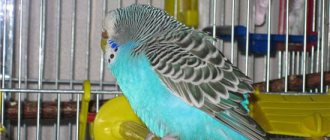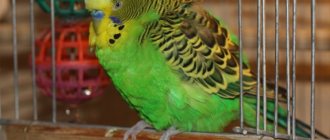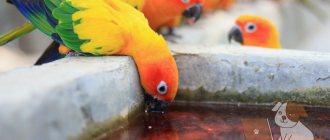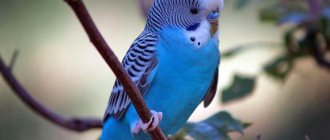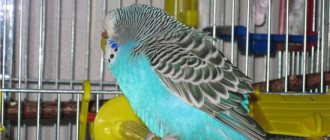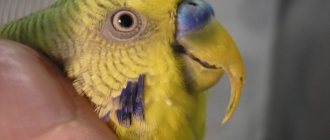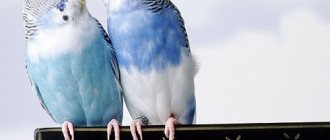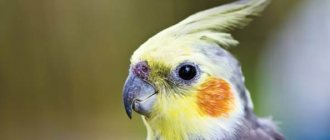Poultry is exposed to various diseases. The presence of illnesses can be determined by the consistency and color of the droppings. It is recommended to carefully monitor the condition of bird feces. If any abnormalities are detected, you should consult a veterinarian.
Liquid droppings in a parrot can occur for various reasons:
- incorrect conditions of detention;
- poor quality food;
- contaminated water;
- lack of lighting;
- unexpected loud noise;
- stress during transportation or change of place of detention.
If diarrhea is detected in a parrot, you should carefully examine the stool, determine the color, and the presence of bloody discharge.
Possible diseases.
Before talking about changes in the color and consistency of the droppings, you need to know exactly what kind of stool should be. Normal feces look like a twisted spiral, greenish-brown in color with a white fragment.
YOU SHOULD REMEMBER! Bird stool can change color depending on its diet. Various foods give the characteristic color to bird poop.
If a parrot has a lot of water in its droppings, this indicates diarrhea or polyuria. Diarrhea occurs due to disruption of the gastrointestinal tract. Diarrhea takes on a vague and soft appearance.
Polyuria is a disease that results in the inability to absorb fluid from the intestine. The stool is formed, but liquid is present separately.
Consequences and complications of diarrhea
Frequent bowel movements weaken the muscles that hold the cloaca in place. There are times when part of the cloaca falls out, dries out and causes great discomfort to the bird. The parrot scratches the irritated, itchy areas of the prolapsed organ with its claws and pecks at it, trying to relieve the pain. Such discomfort does not give the bird peace; it constantly suffers, wasting its last strength.
Prolonged diarrhea is a threat not only to the health, but also to the life of a budgie. If diarrhea does not stop for more than a day, the following complications are possible:
- the body becomes dehydrated;
- oppression of vital systems begins;
- internal organs cannot cope with intoxication;
- the blood thickens, its circulation becomes difficult;
- food is not digested, immediately passing from the esophagus into the intestines.
Without timely assistance, the parrot quickly loses weight and may die.
A budgerigar is a small bird, but it does not get sick any more easily than a large one. On the contrary, a fragile body is more susceptible to complications. Diseases in parrots often develop rapidly; the bird can die out in a matter of days. If you are unable to help your pet, do not hesitate - contact your veterinarian.
White droppings
Finding white, beige or grayish stool indicates fatty foods in your parrot's diet. With this symptom, all types of nuts and sunflower seeds are excluded from the food.
If the stool is of a normal color, but there is a lot of white or liquid inclusions in it, you should immediately contact a veterinary clinic. The presence of such a symptom indicates a serious illness - arthritis, or severe stress.
Treatment.
To normalize the parrot's white liquid droppings, complex treatment is prescribed. Balanced nutrition is provided. Vitamins are included in the diet. Do not unnecessarily disturb the bird. A calm state will help her recover faster.
Symptoms
Experienced owners of pet parrots know that any atypical and seemingly “wrong” behavior of a bird is a warning factor, a possible signal of impending problems.
A chick suffering from diarrhea sometimes sits on a perch, but more often sinks to the bottom of the cage, assuming a tense, bent and mussed body position.
An upset stomach affects the behavior of the pet - the parrot falls into an apathetic, sleepy state, closes its eyes and does not respond to external stimuli. Sick birds also vomit and refuse to eat, showing an almost complete loss of appetite.
Systematic diarrhea disrupts external cleanliness and hygiene - the parrot's feathers become dirty, including from liquid droppings.
Yellow droppings
Coloring the stool in green, yellow or yellow-green shades means obvious poisoning. The cause of poisoning can be determined by the consistency of the stool. Yellow liquid droppings in a parrot indicate poisoning of the body as a result of the negative activity of parasites (ticks, worms, fleas). Poor quality food and water contaminated with parasites can also disrupt the normal consistency of a bird’s stool.
Treatment.
As first aid, the owner can alleviate the condition of his pet with dietary porridge. Steaming is recommended as a cooking method. This method allows you to preserve the beneficial substances of the cereal.
Activated carbon is used. The tablet is ground into powder and steamed porridge is sprinkled (it is better to use rice). You can give an infusion of chamomile as a drink.
Green droppings also occur as a result of a lack of calcium. For treatment, it is recommended to purchase good quality chalk or sprinkle the food with calcium gluconate.
As a result of laboratory tests and determination of external symptoms of the disease, the veterinarian prescribes medications. The main medicine is Karsil. To increase immunity, the pet is given Gamavit for a week, at a dosage of 0.5 of the drug per 50 ml of purified water. Smecta and Enterosgel are also used for treatment.
Diseases
As mentioned earlier, diarrhea is a symptom indicating the presence of a particular disease. Indigestion rarely occurs “on its own”, almost always as part of some pathology. At the same time, the owner is faced with an important task related to establishing the exact cause of the appearance of the corresponding symptoms.
An excessive number of disorders acquired by a parrot affects the condition of its esophagus. In order to begin competent and timely treatment, you need to establish the correct diagnosis.
Ascariasis
Ascariasis is a classic helminthic pathology caused by foreign pests that have entered the esophagus. You can understand that a parrot is suffering from diarrhea, which arose precisely from this disease, by the following symptoms:
- loose stools with frequent blood spots;
- complete or partial loss of appetite;
- poor hygiene, disheveled appearance;
- limbs and mucous membranes acquire light shades.
Aspergillosis
Aspergillosis is an extremely dangerous disease that can cause irreparable harm to a pet’s health. The presence of this pathology can be determined by the presence of the following symptoms:
- loose bloody stools;
- bluish tint to paws;
- seizures;
- elongated neck;
- regular sneezing with mucus discharge from the nasal openings;
- refusal of food and excessive fluid intake.
Inflammation of the peritoneum and intestines
Inflammation of the peritoneum and intestines is probably the most common cause of diarrhea. The presence of this pathology is determined by a swollen abdomen of a reddish hue. The copious bowel movements from which the parrot suffers take on dark and dark brown tones. An excessive number of disorders acquired by a parrot affects the condition of its esophagus.
Another visual sign of inflammation is the visibility of intestines through the pet's abdomen.
Gastroenteritis
Gastroenteritis is a disease associated with infection of the mucous membranes of the stomach and intestines. You can tell that a bird is suffering from such a pathology by frequent, excessively thin, foul-smelling and foaming yellow-green diarrhea. Another sign is a change in the pet’s mood - the bird is in constant apathy and does not react to external events.
Hepatitis or hepatosis
Hepatitis, as well as hepatosis, are particularly dangerous pathologies that can cause irreparable harm to the health of a feathered friend. The presence of diseases can be determined using symptoms:
- visually noticeable bloating;
- dark brown and brown stool;
- dermatitis.
Flu
Classic influenza is a serious illness with a high risk of all sorts of complications. The intensifying disease spreads to the internal organs, causing serious harm to the health of the pet. The presence of a sore can be determined by the corresponding symptoms:
- diarrhea;
- feverish condition;
- fever or chills;
- excessive mucus discharge from the nasal openings;
- frequent sneezing;
- swelling of the cervical region and head.
Cloacite
Cloacitis is a disease common in young individuals. Pathology is an inflammation that occurs in the area of the mucous membranes located inside and outside the cloaca. The main signs indicating the presence of such problems include:
- apathetic behavior;
- lack of response to external stimuli;
- loss of appetite;
- excessive and heavy drinking;
- clumping of feathers and a ruffled appearance;
- redness in the cloaca area.
Coccidiosis
Coccidiosis is a pathology that occurs as a result of damage to the body by all kinds of pathogenic bacteria, which are prokaryotes (protozoan microorganisms). An excessive number of disorders acquired by a parrot affects the condition of its esophagus. You can understand that a bird has become ill with coccidiosis by the list of reasons:
- diarrhea;
- stool takes on a greenish or brownish tint;
- discharge of blood during diarrhea;
- refusal of food;
- apathetic behavior;
- tousled look.
Colibacillosis
Colibacillosis is a disease with more than a dozen different forms. Loose and frequent stools are a symptom of an intestinal pathology. In addition to severe diarrhea, a parrot suffering from colibacillosis refuses to feed, loses thirst and suffers from inflammation in the joints.
The occurrence of various disorders in the area of defecation corresponds to the appearance of symptoms of various diseases.
Goiter obstruction
Goiter obstruction is probably the most “harmless” disease, often amenable to immediate treatment. An excessive number of disorders acquired by a parrot affects the condition of its esophagus. You can understand what the symptoms of goiter obstruction look like based on the following factors:
- refusal to feed;
- large and excessively hard goiter;
- frequent bowel movements;
- the appearance of shortness of breath;
- apathy, lack of reaction to external events;
- weight loss;
- undigested grain in feces;
- pungent odor from the mouth.
Gout
Gout is a pathology that occurs as a result of problems associated with protein metabolism disorders. Throughout the course of the disease, a large amount of uric acid salts are deposited in the pet’s body, which causes most of the subsequent symptoms:
- weight loss;
- lack of appetite;
- lameness and dishevelment;
- the joints are “decorated” with small yellow nodes;
- redness of the mucous membranes in the cloaca area.
Cold
Most colds manifest themselves as a result of weakened immunity or occasional drafts and drops in temperature. When such a pathology appears, the owners begin to think about the question of how to give the parrot medicine. In addition to loose stools, a bird with a cold suffers from symptoms such as:
- refusal of food;
- secretion of excessive mucus from the nasal openings;
- regular sneezes;
- increase in body temperature;
- neck stretching;
- shortness of breath resulting from frequent and prolonged opening of the beak.
Psittacosis
Psittacosis is a pathology that is extremely dangerous to the health of birds and even people. The incubation period of this disease lasts 10-14 days. A bird suffering from psittacosis loses sleep and appetite, plunges into apathy and suffers from rhinitis. The occurrence of various disorders in the area of defecation corresponds to the appearance of symptoms of various diseases.
Salmonellosis
Salmonellosis is another helminthic disease caused by the presence of foreign bacteria in the stomach and intestines of a pet. Symptoms are similar to aspergillosis:
- loose stools with frequent blood spots;
- complete or partial loss of appetite;
- poor hygiene, disheveled appearance;
- limbs and mucous membranes acquire light shades.
Stress
A parrot's stress can also cause both relatively harmless polyuria and more severe digestive disorders.
When a pet is frightened or very anxious, the adrenal glands release the steroid hormone cortisol, which affects almost all systems of the body. Its accumulation during prolonged or frequent stress leads to disruption of vital organs, including the intestines.
Stress affects your budgie's stool
Why does budgies get constipated?
The reasons for the occurrence of this disease are different. To cure, it is necessary to correctly establish why the poor bird cannot part with the digested food.
Stressful situations
You will be surprised, but constipation can occur after a housewarming party. Changing a place of residence is a lot of stress for a bird. A new place, a new environment, everything around is unclear and scary. This is the “nervous” form of the disease. The bird needs to be unobtrusively helped to get comfortable, without disturbing it again.
A stressful situation is one of the causes of constipation in a parrot
Fatty food
For those who like to eat tasty, fatty meat, the winged pets can steal a piece from the plate, or even right from the fork. The owner is touched, the pet is happy. But the liver protests. Fatty foods overstrain the liver and cause increased bile production. And fats constantly entering the body will lead to hepatic lipidosis.
Even excessive consumption of seeds and nuts can upset digestion and cause constipation in your budgie.
Lack of water
Normal feces are formed only with sufficient water. Excess grain in the diet can cause problems with bowel movements. After all, the grain must be softened by water so that the formed feces can leave the body unhindered and easily. You need to make sure that the bird always has fresh, clean water.
Constipation is caused by lack of water
Poor quality or stale food
Eating such a product can lead to both constipation and diarrhea, depending on your luck. Both ailments are unpleasant and can lead to complications. Therefore, feed your bird high-quality, fresh, not stale food.
Intestinal infections
Infectious diseases of the gastrointestinal tract provoke both constipation and diarrhea. Most often it is diarrhea. Usually antibiotics are used for treatment, but here the help of a doctor is necessary.
Helminth infection
Helminthiasis (or simply worms) can appear in a parrot, even if the bird has never been outside.
Where will the worms come from then?
Very simple. Worm eggs and bird droppings land on grain and grass and wait quietly. Such grain can end up in food, even those purchased at a pet store. This is where the larvae eaten by the parrot will begin to develop. Helminthiasis is guaranteed for your pet.
Where do worms come from in a parrot?
Self-infection is possible. This is when you performed anthelmintic treatment on the bird, but the cage was not disinfected. The remaining helminth eggs (you won’t see them, but they are there) will easily fall back onto the food, and re-infection will begin.
Poultry obesity
A good appetite in animals is an indirect sign of health. But if the pet eats a lot, loves to take part in the master's feasts, and never refuses a tasty piece, then the bird is at risk of obesity. As in humans, it is a general disease that affects the entire body. But, of course, first of all, the gastrointestinal tract suffers. He may simply not have time to process everything that the little glutton swallowed. Obesity is aggravated by the parrot's sedentary lifestyle.
Shards of stone or chalk
Every caring owner will have a stone, chalk, and sepia in their bird house for grinding down the beak. When a bird uses them, it can swallow pieces of it. They will cause constipation in the parrot.
Pieces of stone or chalk can cause constipation in a parrot
Adjusting your diet
During treatment, dry grain mixture, greens, fruits, fatty seeds and nuts, treats, and cottage cheese are excluded from the diet. After recovery, the old food should be replaced with a new pack.
While the bird is unwell, it may refuse to eat. The exhaustion of the bird will quickly end in its death if you do not force feed it from a syringe. To do this, use boiled buckwheat, rice, millet porridge or a mixture for chicks.
If your pet does not allow you to give him food or spits it out, you can insert part of the tube from the injection catheter into the parrot's crop and inject food through it. The device comes in different diameters. For wavy catheters, a pediatric butterfly catheter is used.
Treatment
If pathological deviations in the appearance of the litter are detected, you should seek help from a veterinarian as soon as possible. He will examine the bird, make a diagnosis and prescribe treatment. You should not independently draw conclusions about the reason for the change in the appearance of feces and give your pet any medications: this can harm the bird. The exception is the presence of blood in the droppings. Bleeding is dangerous, so to stop it, the parrot is given Dicynone (1 drop per 4 drops of water once a day). This drug can be given for no more than 3 days.
